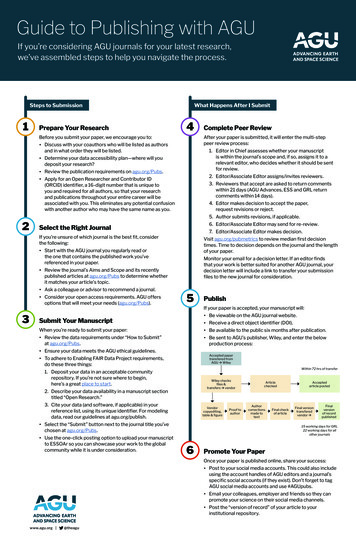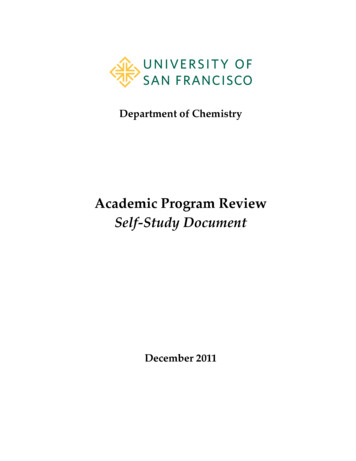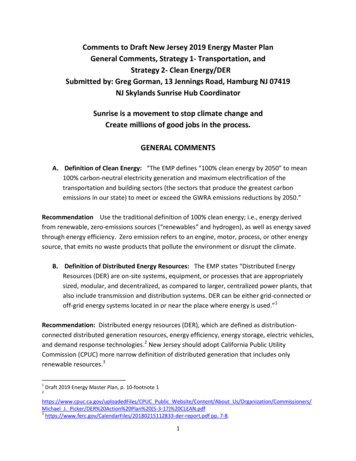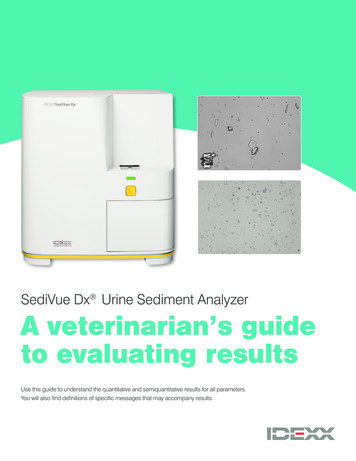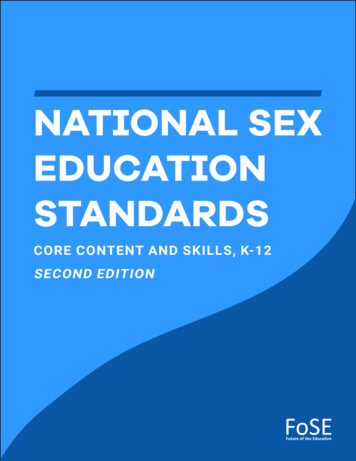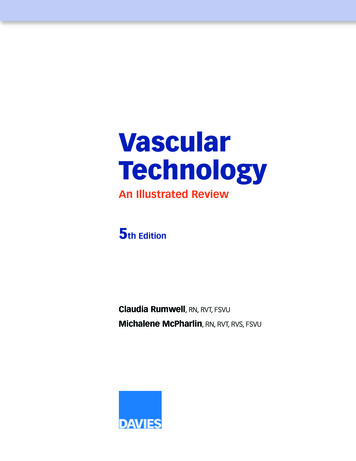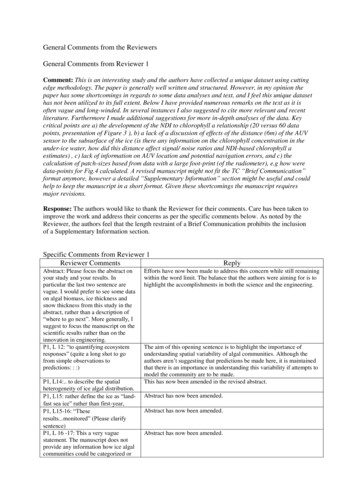
Transcription
General Comments from the ReviewersGeneral Comments from Reviewer 1Comment: This is an interesting study and the authors have collected a unique dataset using cuttingedge methodology. The paper is generally well written and structured. However, in my opinion thepaper has some shortcomings in regards to some data analyses and text, and I feel this unique datasethas not been utilized to its full extent. Below I have provided numerous remarks on the text as it isoften vague and long-winded. In several instances I also suggested to cite more relevant and recentliterature. Furthermore I made additional suggestions for more in-depth analyses of the data. Keycritical points are a) the development of the NDI to chlorophyll a relationship (20 versus 60 datapoints, presentation of Figure 3 ), b) a lack of a discussion of effects of the distance (6m) of the AUVsensor to the subsurface of the ice (is there any information on the chlorophyll concentration in theunder-ice water, how did this distance affect signal/ noise ratios and NDI-based chlorophyll aestimates) , c) lack of information on AUV location and potential navigation errors, and c) thecalculation of patch-sizes based from data with a large foot-print (of the radiometer), e.g how weredata-points for Fig.4 calculated. A revised manuscript might not fit the TC “Brief Communication”format anymore, however a detailed “Supplementary Information” section might be useful and couldhelp to keep the manuscript in a short format. Given these shortcomings the manuscript requiresmajor revisions.Response: The authors would like to thank the Reviewer for their comments. Care has been taken toimprove the work and address their concerns as per the specific comments below. As noted by theReviewer, the authors feel that the length restraint of a Brief Communication prohibits the inclusionof a Supplementary Information section.Specific Comments from Reviewer 1Reviewer CommentsAbstract: Please focus the abstract onyour study and your results. Inparticular the last two sentence arevague. I would prefer to see some dataon algal biomass, ice thickness andsnow thickness from this study in theabstract, rather than a description of“where to go next”. More generally, Isuggest to focus the manuscript on thescientific results rather than on theinnovation in engineering.P1, L 12: “to quantifying ecosystemresponses” (quite a long shot to gofrom simple observations topredictions: : :)P1, L14:. to describe the spatialheterogeneity of ice algal distribution.P1, L15: rather define the ice as “landfast sea ice” rather than first-year,P1, L15-16: “Theseresults.monitored” (Please clarifysentence)P1, L 16 -17: This a very vaguestatement. The manuscript does notprovide any information how ice algalcommunities could be categorized orReplyEfforts have now been made to address this concern while still remainingwithin the word limit. The balance that the authors were aiming for is tohighlight the accomplishments in both the science and the engineering.The aim of this opening sentence is to highlight the importance ofunderstanding spatial variability of algal communities. Although theauthors aren’t suggesting that predictions be made here, it is maintainedthat there is an importance in understanding this variability if attempts tomodel the community are to be made.This has now been amended in the revised abstract.Abstract has now been amended.Abstract has now been amended.Abstract has now been amended.
how productivity could be measured. Isuggest to delete and re-write abstractas per above comments.Introduction: P1, L 23 -24: Please bemore specific. Focus could be on theentire Southern Ocean (e.g. Saenz &Arrigo 2012, Arrigo 2014, Meiners etal. 2012) or Antarctic fast-iceecosystems. Rysgaard is an older (andArctic) reference. Maybe cite Mundyet al. 2007 and the recent papers ofCampbell et al. 2014, 2015?P1, 28 -29: This statement is true forArctic sea ice and Antarctic land-fastsea ice, but not necessarily true for“Antarctic sea ice” (see Horner et al.1992, Arrigo 2014).P1, 29-31: Please clarify sentence(Significance of what?)P2, L1: Classic work on ice algalpatchiness in Antarctic land-fast seaice has been conducted by Swadling etal. (1997). This would be a goodcitation.P2, L5: Maybe re-phrase? “Linksbetween ice algal biomass and theunder-ice light field are wellestablished P 2, L 9-10: As far as I understandNDI explain variability in the biomass(e.g. in a dataset used for calibrationefforts), but a NDI does not explainspatial variability! Please correct thissentence.I suggest major re-write of theintroduction. It should provide anoverview of a) the importanceof Antarctic land-fast sea ice studiesand b) recent advances in technologiesto measure ice algal biomass noninvasively.Methods: P2, L 13: This study did notmeasure transmittance! Transmittanceis defined as the ratio betweenincoming solar radiation at the surfaceof a medium and the amount ofradiation at the bottom of the medium.Rather than “spectral properties oflight transmittance” the “multi-spectralunder-ice irradiance” was measured.Please use proper terminology.P2 L17-18: “patches a few metersacross” and “very small (1s to 10s ofmeters” is duplicated information, Isuggest to rewrite/combine thesesentencesP2, L18: report snow thickness in “m”Citations have now been updated to better reflect the material.Amended to now read:‘Sea ice algae in McMurdo Sound, Antarctica comprise a shade-adaptedautotrophic assemblage ’Amended to now read:‘The significance of this algal community to marine ecosystems as aconcentrated food resource prior to ice break-up, and its potential rolein seeding pelagic production subsequent to ice break-up, are widelyrecognized (Arrigo & Thomas, 2004).’Citation has now been added and the authors would like to thank thereviewer for this suggestion.The phrasing here has now been kept the same but the citations havebeen updated to reflect more current work and the expansion into remotesensing techniques.This sentence has now been slightly modified by removing the word‘spatial’.Changes have been made to the Introduction to improve the flow butstructural the authors feel that it was important to maintain the key ideasof ice algae / patchiness / NDI as this links to the rest of the paper. As fornew, emerging technologies for non-invasive sampling, this has been leftfor the Discussion as there have been so few studies to date.This has now been corrected as suggested.This has now been corrected as suggested.This has now been corrected as suggested.
(SI unit) rather than “cm”P2, Line 23: replace “Southern Ocean”with “land-fast sea ice in McMurdoSound”.P 2, L25: Could you please provide alinear regression and an R2 for the icethickness (measured from cores)versus ice thickness (measured fromthe sonar) relationship. This wouldgreatly help to understand sonar-basedice thickness error.P2, L30: “greater spatial precision”,please provide information on theAUV positioning system and itsaccuracy, it might be useful to citerecent AUV (Katlein et al. 2015, JGR)hereP3, L4-5: Given the speed of thevehicle and the downsampling to 1Hzthere will still be some overlap of thearea measured. Was this accounted for(e.g. through calculating a runningmean?)P3, L 10: Are there any measurementsof the Chlorophyll a concentration inthe underice water available? Howdoes integrated Chla in in the 6m ofwater-column compare to theintegrated Chla concentration in theoverlying sea-ice? This would be veryuseful information to understand thesignal:noise ratio in the measurements.P3, L 28: “two volumes”? , please bemore specific and maybe add areference for this methodologyP4, L1: please provide reference formethod of determination ofchlorophyll aP4, L13-15: Much more detail isrequired how the calibration of theAUV data was “tuned”. It would bepreferable to 1) show the results fromall (60?) sites where ice cores andradiometer measurements were takensimultaneously and to discuss thederived best NDI (e.g. to compare withThis has now been corrected as suggested.A more explicit validation of this technique using these datasets has justbeen published in Lucieer et al. (2016).Lucieer, V., Nau, A. W., Forrest, A. L., & Hawes, I.: Fine-Scale Sea IceStructure Characterized Using Underwater AcousticMethods. Remote Sensing, 8(10), 821, doi:10.3390/rs8100821,2016.This reference and the mean difference of 0.11 m between measurementtechniques has now been included.This has now been corrected as suggested.While there will be some overlap at 1Hz, the data are presented as pointvalues rather than estimating a running mean. All this would do wouldbe to further smooth the signal and so wasn’t presented here.No direct measurements of Chla concentrations were made in the water;however, in addition to the Satlantic OCR507 multispectral radiometer,the AUV was also making estimates of Chla using a Wetlabs Ecopucksampling at 4Hz. The values recorded were at the minimum detectionlimit of the instrument and so it was assumed that the concentrations inthe water column were minimal. However, in order to address theproblem of attenuation through the water column, a TriOS Ramses ACCVIS cosine-corrected hyperspectral radiometer was used to deriveattenuation coefficients for the different wavelengths. These profileswere then used to correct for water column attenuation as detailed in textto address the question of the influence of the water column on theobserved results:‘To account for variable AUV depth and ice cover thickness, the spectralirradiance at each wavelength was calculated for the ice-water interfaceusing a vertical exponential attenuation model. This combinedwavelength-specific attenuation coefficients for transmitted irradiance(Kirk, 2011), measured on site, with AUV depth below the underside ofthe ice estimated from sonar measurements of overhead ice draft.’This has now been amended to read ‘adding two times the volume ofmelted seawater’ as per the protocol established by Rintala et al. (2014)[reference added].Reference has now been added.For clarification, there were 20 stations where ice cores were collected intriplicate (i.e., three samples with a 1.2 m diameter). As these sampleswere so close together, it wasn’t possible to use individual measurementsfor the NDI calculation using the Satlantic signal as the footprint of theSatlantic was 4 m in diameter, and there was often some considerablevariability in chla content of “replicate” cores at each station. For thesereasons, the TriOS data were used to develop the NDI, and we used theaverage results of the triplicate sites (note that N 19 in the caption for
results from previous NDI studies) 2)show how these results were affectedfrom discarding “selected” cores 3)show/explain the AUV calibrationtuning method in detail and discusspotential error propagations throughthese 3 steps Also please explain NDI“(Ratio)” as x-axis descriptor in Figure3. Is this indicating a furthernormalization of the originallydetermined NDI results, or should thisread just “NDI” Figure captionindicates: N 19, but it appears that it isN 20.? Text indicates 14 samplingsites with a total of 60 “replicate”measurements Are these results fromthe 14 or 20 sites or is this a randomsubset of the 60 individualmeasurements. It appears that using thefull 60 individual measurements wouldresult in a stronger statisticalrelationship of NDI versus integratedalgal biomass. “Damaged” core couldbe plotted in a specific colour. Thiswould make are stronger argument forthe used NDI to chla relationship(which has a relatively poor fit).Results: P4, L 21: do you mean“interstitial AND in the platelet ice”,e.g. in figure 3 samples aredistinguished between “interstitial”versus “platelets”. Please clarifystatement.In addition, algal communities inFigure 2b and 2d are looking differentto those pictured in 2a and 2c. Algae in2b and 2d closely resemble “stand”communities as commonly found inthe Arctic. Were strands also evidentin any of the core samples?P4, Line 26: I understand that the NDI(470 nm : 565) was used forcalibration of the multi-spectral AUVbased measurements but please alsoshow the best NDI to Chla relationshipthat was derived from the 60 pointmeasurements. This might help futurestudies in selecting the bands of AUVmounted radiometers.P 4, L 26: Given that for NDI (470 nm: 565 nm) versus Chla the R2 was only0.403, I doubt that this NDI explainedthe “highest proportion of thevariability in algae biomass”P5, L5: In this paragraph I would juststate that the poor predictive power ofthe algorithm was a result from thelimited number wavelengths availablefrom the AUV mounted radiometer.Again it would be good to show theFigure 3 has now been amended to N 20 as detailed in the text) tointegrate over a larger footprint area given the small-scale variability thatwas apparent in the core data. The “tuning” of the NDI that the reviewerrefers to was undertaken as the geometric mean of chl-a concentrationsderived from applying the TriOS-derived NDI to the Satlantic data was18.7 compared to 26.7 from the measured ice cores. The reason for thisis not clear, but we considered likely to result from optical measurementdifferences in the band-pass instrument (Satlantic) and the higherresolution hyperspectral (TriOS) instrument.The references to discarding cores refers to one of the three replicates attwo different stations. Efforts were made in the field to capture thebottom fragments by including pieces from within the hole. However,chla values were substantially lower than in some replicates and so werethus discarded from the analysis. The following line has now beenincluded to provide clarity: ‘Of the 60 cores total that were collected,only one replicate from 2 different stations were so damaged.’Finally, both the caption and the axes label of Figure 3 has beenamended to only read NDI to avoid any confusion as there was no furthernormalization. This was originally included to indicate a variable withoutunits.This has now been corrected as suggested.While the authors agree with the reviewer that there are similarities withstrand communities, and there was attachment of algae on platelet ice(e.g. Figure 2b), strands were not observed in any of the cores.This point has been discussed in reply to the previous comment by thereviewer.While the authors agree that the R2 is low, the intent of this sentence wasto say that this NDI explained the highest proportion of the variability inalgae biomass results, not in a global context. To provide clarification,‘results’ has been added to the sentence.This paragraph has now been amended to reflect both possible reasonswhy this might be the case.The authors are unsure what to address here as the best results have been
best NDI to Chla relationship asderived from the highresolution/hyperspectral pointmeasurements.P 5, L 7: I suggest to delete referenceto “multi-year sea ice was largelyabsent”. Was there any multi-year seaice in your sampling area of 500 x 500?P4, Line 11: shorten “we consider itpossible to assume” ?Figure caption 1: “.where spectralintensity measurements were made(CE1, CE2 and CE3) across 60 mswaths”, please specify if thisstatement is correct. In the Methodssections it is explained that that thefootprint of the radiometricmeasurements was about 4m indiameter. This is contradicting 60 mwide swaths.Figure 3: I suggest to show data with alog scale y-axis starting at 1 andending at 100 mg Chla m-2. Thecurrent y-axis starting at 5 and with amaximum of 100, and at the same timeshowing “linear” axis-descriptors isconfusing. Why are only 20 data pointsshown, when you have measured 60?It would be preferable to see all 60paired measurements of Chla versusNDI.P5, L 17-18: Clarify sentence thereseems to be an “and” missing.Discussion: P 5, L 23-24: No data onthe varying amplitude and lengthscales of patchiness for spectralirradiance are shown. Please be morespecific in the terminology used todescribe your data.P5, L 23-24: “For each transect, chlaestimates were interpolated to constantspacing between samples to allow aspectral analysis of the data using astandard Fast Fourier Transform (FFT)similar to time series analysis”. Thisinformation needs to go in the Methodspart of the manuscript. Define“constant spacing”. Is this the lengthscale ofthe radiometric foot-print of approx. 4m in diameter? Please detail youproduced the data presented in Figure4. They seems to have a higherresolution than the maximumresolution that can be achieved by themeasurements, e.g. the 4 m sensorfootprint.P5, L 26-27: Please show thesecorrelograms (maybe in apresented in this work already.The reference to multi-year sea ice has been removed although thesentence was left in there to describe the snow conditions.This has now been amended to ‘we assume’.In rereading this caption, it is understood how the description of thesonar swath (60 m) could be misleading to the reader. The caption hasnow been amended.The authors feel that 60 cores collected at the 20 stations has beenexplained previously and has also been clarified in the text.The limits of the y-axis of Figure 3 has now been amended to go from 1to 100 for better clarity.This has now been corrected as suggested.This sentence has now been amended to be more exact.This has now been amended. The data reported in Figure 4 is at asampling frequency of 1Hz (i.e. the raw data) and so is not the data thatis then smoothed at a 1 m constant interval setting to conduct the FastFourier Transform. This is because FFTs require a constant spacing thatisn’t possible when the AUV has irregular surge.The authors have chosen not to include correlograms in this very shortcommunication.
Supplementary Information section?).Variograms have been calculated forlight transmission in Arctic sea ice andthis would allow for interestingcomparisons (Katlein et al. 2015).P6, Line 3: There are more relevantreferences available for the spatialvariability of ice algal biomass, e.g.Rysgaard et al. 2001, Steffens et al.2006: Søgaard et al. 2013). I suggest tocite these and discuss new data (thisstudy) in relation to these previousstudies.P 6, Line 10: Here it would be good tocite and relate to some other studiesthat investigated snow – ice algalbiomass relationships. One additionalsentence about potential thresholds inthe snow ice algal relationship and theseasonally changing influence of snowon ice algae would be useful.P6, Line 15: One would assume thatmost possibly platelet ice – (partly)consolidated into the ice sheet wasdriving the biomass distribution. FromFigure 3 it appears that platelet ice wasassociated with higher algal biomass.Could the sonar data shed some lightinto this? E.g. could the sonar data beused to detect platelet ice patches –presumably associated with a highersurface roughness? This study providesa uniquedataset for testing this. Rather thanmentioning this as a hypothesis, Isuggest to use the data to test thisrelationship.P6, L 7: Are there any ice draft dataavailable from the other two transects?Why were analyses of the correlationbetween ice draft and NDI-derivedalgal distribution restricted to thissingle transect?P 6, L 17-22: Please clarify both thesesentences. Do you want to say: “Thepoor NDI to Chla relationship does notallow for more complex analyses ofthe relationships between physical seaice properties and ice algal biomass.Nevertheless, our data provide proofof-concept to use AUV technology tomeasure ice algal spatial variability"?P6, Line 24: please define “infiltrationice” ?P7, L3: “fast ice” rather than “firstyear sea ice”P7, L6: “well above” rather than “wellbelow”? One could argue that most icecore studies work on areas of 10m byReferences to earlier work by Rysgaard et al. (2001), Gosselin et al.(1986) and Swadling et al. (1997) have now all been included. Whilethese other authors have identified a wide variation in scales, theadvantage of our current work is that it is unique in that the transect linesprovide continuous lines of coverage from which the length scales ofvariance can be estimated. The text has been amended slightly to providegreater clarity.A citation for this has now been added and the potential thresholds in thesnow ice algal relationship has been left for other discussions in theinterest of space in a Short Communication as well as the fact that veryminimal snow existed in the region.The reviewer makes a good point here that has been explored in somedetail by Lucieer et al. (2016). However, determining platelet structurefrom the sonar measurements hasn’t been developed enough as a tool todevelop correlation length scales. This is the focus of future work that isalready currently being explored.The reason for this transect being selected is that it had the greatestdegree of variability in the ice structure and was meant to be the greatestexample of this. The other two transects were essentially level ice and soweren’t provided.The text has now been amended to provide better clarification.This should have read ‘interstitial ice’ and has now been amended.This has now been corrected as suggested.This has now been corrected as suggested.
10m.P7, L 7: “ice coring” rather than“sample coring”P7, 9: “this most cryptic of sea icealgae communities”? most crypticcompared to what other communities?Figure 4: a) Why is sea ice draft onlyshown for one transect, when data forall 3 transects are available ( see Fig.1)b) What is the bin-size for thechlorophyll a lines. It appears that theyare shown at a higher resolution than 4m, but in the text 4 m (radius) is givenas the radiometric foot-print of thesensor. Please explain and adjust (bin)chla values to 4 m length scale - ifnecessary.This has now been corrected as suggested.This has now been amended to avoid ambiguity.This comment has been previously addressed.General Comments from Reviewer 2Comment: Overall the information presented represents valuable information regarding thefeasibility of using optics to infer algal biomass in sea ice and the horizontal variability of such inland fast ice of Antarctica. That said, there are several areas in the ms that deserve improvements.Among the areas that need improving is work to provide better citations that will help place thecurrent work in better context of the scientific progress over the past 20 years. Additionally, bettercitations will help the authors to provide better and more accurate information regarding sea ice andsea ice biota. Specific examples are given below.Author Response: The authors would like to thank the Reviewer for their comments. Care has beentaken to improve the work and address their concerns as per the specific comments below.Specific Comments from Reviewer 2Reviewer CommentsPage 1: First sentence of abstract (line12) is hyperbole and not needed.Line 23- There are much betterreferences than just one reference fromMcMinn et al 1999 for the assertionsincluding review papers by workinggroups.Line 28 - is an assertion that is simplynot true- the idea that ice algaepredominantly grow at the bottom ofthe sea ice is a fallacy propagated bythinking that McMurdo sound sea iceis representative of 20M sq kilometersof sea ice- when in fact ice algae growthroughout all sorts of areas of the seaice in the pack ice regimes. Moreover,fall blooms are also common- refer tothe work by Garrison and others aswell the Japanese authors on the topic.Page 2: line 5- again only onereference is not sufficient - e.g. citingPalmisano’s work would beappropriate.ReplyThe abstract has been amended significantly in reflection from the firstreviewer; however, the first sentence remains relatively unchanged. Theauthors feel that this is important to place the study in context.This has now been corrected as suggested.This sentence has now been amended to be specific about McMurdoSound rather than being overly general.This has now been corrected as suggested.
Page 3- line 24- Sullivan et al’s priorwork in the 80’s also quantified thepercentage of the biomass in differentlayers of the bottom ice.Page 4 line 13- 14- the sentence isvery hard to translate. How did theyscale the estimates? what does thismean? was there a correction factorapplied and if so, how?Page 5- line 6- referencing somethingthat may or may not be publishedsomewhereelse does not seem like it should beallowed.line 10 - same issue- it seems relevantto present the data herein.Page 6 line 7 - the sentence is veryawkward- and meaning is obscured.Suggest re-writing to clarify.Page 7- line 2- the term pioneeringseems a bit much as this does not seemlike pioneering work. There has beenmuch work on this topic and approachalready. More appropriately theincremental work demonstrates abilityto use place optical instrumentation onunderwater vehicles to try to estimatebiomass over larger spatial scales.line 10- assertion that newunderstanding is possible- would bemore convincing if the authorspresented on this manuscript what newunderstanding they have provided bydoing the exercise. The ms does notconvince me that they havecontributed more understanding yet.Perhaps if they did a rigorous spatialanalysis of their transects toinform us of the spatial scales ofpatchiness or autocorrelation THEN Icould see that they might be providingbetter and new information for betterunderstanding sea ice and sea icealgae.Figure 1- the orientation of Antarcticain the inset looks transposed. The texton the transect figure inset make thisfigure problematic- it is not readableFigure 4- it would be nice to add apanel that shows the depth of theradiometers on the vehicle as it madethe transect.Fig 4c- does the repeat of the linesimply there is a lack of repeatability ?is there an issue being hid hearconcerning the stability of theWhile it is true that the work of Sullivan is important, the authors feelthat this is addressed by referencing the work of Ryan et al. (2006) andCarnet et al. (2014).This question was also addressed by the other reviewer and, similar tothe previous response, is addressed in the text:‘To account for variable AUV depth and ice cover thickness, the spectralirradiance at each wavelength was calculated for the ice-water interfaceusing a vertical exponential attenuation model. This model combinedwavelength-specific attenuation coefficients for transmitted irradiance(Kirk, 2011), measured on site, with AUV depth below the underside ofthe ice estimated from sonar measurements of overhead ice draft.’The text has now been modified to remove any ambiguity with othermanuscripts being developed.The text has now been modified to remove any ambiguity with othermanuscripts being developed.This sentence has now been amended for better clarity.While the authors still feel that the use of AUVs for this application ispioneering, the text has been amended.The authors feel that this was the aim in presenting both the correlogramsas well as the FFT analysis of the spatial data (i.e. first paragraph of thediscussion).The orientation of this has now been fixed and the depth of snowcoverage has been deleted as it is minimal. This is also discussed in detailin Lucieer et al. (2016).As the vehicle operates at a fixed hydrostatic depth (6 m; first paragraphof the sampling design) it was decided not to add this panel in as it wasfelt that it didn’t add much to the discussion.The purpose of the three subplots was to show a different hypothesis ineach: 1) that the results were reproducible at different times of the dayover the same transect; 2) that the observations made weren’t related tothe overhead ice draft; and, 3) that the results between transects were
incoming surface radiation during themeasurements?similar but not exactly the same. The aim was to examine this data ineach possible testable hypothesis.
Arctic) reference. Maybe cite Mundy et al. 2007 and the recent papers of Campbell et al. 2014, 2015? Citations have now been updated to better reflect the material. P1, 28 -29: This statement is true for Arctic sea ice and Antarctic land-fast sea ice, but not necessarily true for "Antarctic sea ice" (see Horner et al. 1992, Arrigo 2014).



